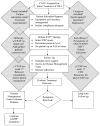A systematic review of CPAP adherence across age groups: clinical and empiric insights for developing CPAP adherence interventions
- PMID: 21652236
- PMCID: PMC3202028
- DOI: 10.1016/j.smrv.2011.01.003
A systematic review of CPAP adherence across age groups: clinical and empiric insights for developing CPAP adherence interventions
Abstract
Continuous positive airway pressure (CPAP) is a highly efficacious treatment for obstructive sleep apnea (OSA) but adherence to the treatment limits its overall effectiveness across all age groups of patients. Factors that influence adherence to CPAP include disease and patient characteristics, treatment titration procedures, technological device factors and side effects, and psychological and social factors. These influential factors have guided the development of interventions to promote CPAP adherence. Various intervention strategies have been described and include educational, technological, psychosocial, pharmacological, and multi-dimensional approaches. Though evidence to date has led to innovative strategies that address adherence in CPAP-treated children, adults, and older adults, significant opportunities exist to develop and test interventions that are clinically applicable, specific to sub-groups of patients likely to demonstrate poor adherence, and address the multi-factorial nature of CPAP adherence. The translation of CPAP adherence promotion interventions to clinical practice is imperative to improve health and functional outcomes in all persons with CPAP-treated OSA.
Copyright © 2011 Elsevier Ltd. All rights reserved.
Figures


Comment in
-
Understanding the problem of poor CPAP adherence.Sleep Med Rev. 2011 Dec;15(6):341-2. doi: 10.1016/j.smrv.2011.04.002. Epub 2011 May 26. Sleep Med Rev. 2011. PMID: 21620744 No abstract available.
References
-
- Gay P, Weaver TE, Loube D, Iber C. Evaluation of positive airway pressure treatment for sleep-related breathing disorders in adults. Sleep. 2006;29:381–401. - PubMed
-
- Marcus CL, Rosen G, Ward SL, Halbower AC, Sterni L, Lutz J, et al. Adherence to and effectiveness of positive airway pressure therapy in children with obstructive sleep apnea. Pediatrics. 2006;117:e442–51. - PubMed
-
- Sullivan CE, Berthon-Jones M, Issa FG, Eves L. Reversal of obstructive sleep apnea by continuous positive airway pressure applied through the nares. Lancet. 1981;1:862–5. - PubMed
-
- Kribbs NB, Pack AI, Kline LR, Smith PL, Schwartz AR, Schubert NM, et al. Objective measurement of patterns of nasal CPAP use by patients with obstructive sleep apnea. American Review of Repiratory Diseases. 1993;147:887–95. - PubMed
Publication types
MeSH terms
Grants and funding
LinkOut - more resources
Full Text Sources
Other Literature Sources
Medical

